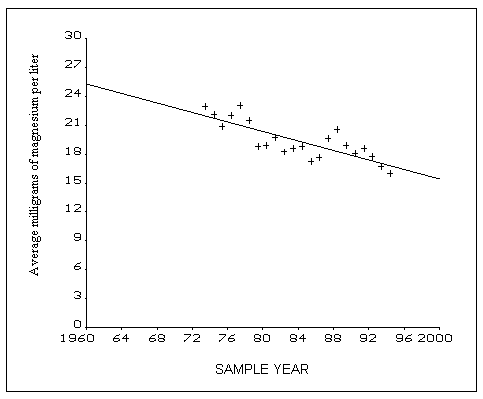Calculations of soil magnesium loss by leaching after advent
of tilling in the Mississippi River watershed
The prime farmland in the watershed of the Mississippi
River may be slowly becoming magnesium depleted. Year after year,
crops are harvested, removing magnesium from the top nine inches
of tilled soil. Tilling also exposes the soil magnesium to the
leaching effects of rain water and runoff. The following
calculations suggest that in the last 150 years over eight
percent of the magnesium in the top nine inches of soil in the
Mississippi River's watershed has run off to the Gulf of
Mexico.
KNOWN FACTS
1. The Mississippi River contains about 17 ppm dissolved
magnesium (1). This does not include magnesium in the
undissolved dirt load, which is a different problem.
2. The Mississippi River discharges an average of 640,000
cubic feet of water per second into the Gulf of Mexico (2).
3. The Mississippi River's watershed is 1,257,000 square
miles (3).
4. The average magnesium content of the soil in the
Mississippi River's watershed is about 250 ppm (4).
CALCULATIONS
1. The annual discharge of the Mississippi River is
20,183,040,000,000 cu. feet of water, which is
571,180,032,000,000 liters.
2. The annual discharge of dissolved magnesium at 17 mg/L is
9,710,060,544,000,000 mg, which is 971,006,544 kilograms of
dissolved magnesium discharged annually by the Mississippi
River (not counting undissolved dirt load).
3. The Mississippi River Watershed is 1,257,000 square
miles, or 804,480,000 acres, which is 35,043,148,800,000 sq.
ft. Assuming that in plowed fields, there is very little chance
of entry of nutrients from below the plowed strata (top nine
inches), the annual runoff of dissolved Mg per square foot is
277 mg.
4. There are 21.2 liters of soil per square foot, nine
inches deep. Mississippi River watershed soils average 255
mg/L. Therefore, annual Mg runoff per liter of soil is 277 mg
divided by 21.2 liters, which is 13 mg/liter of soil.
5. Dividing the annual Mg runoff of 13 mg per liter of soil,
by the average soil content of 255 mg, gives an annual loss of
4.7%.
That loss does not include other losses due to harvesting
and removal of magnesium-rich crops.
However, this would not apply to orchards, whose deep roots
bring up nutrients from below the top nine inches, nor do these
figures take account of deep soils brought to the surface by
earthworms or burrowing animals. Some research has been done on
the surfacing of deep soils, which will be cited soon in an
refinement of these calculations.
DISCUSSION
Not all soil will leach at the same pace. Forests, grasslands,
grazing lands, roadways, and urban areas cannot be expected to
lose magnesium nearly as fast as tilled fields do. Geologic eons
are needed to leach magnesium from protected soils, else all the
magnesium would have leached away eons ago.
Computer analysis of satellite photos can determine the exact
percentage of the Mississippi River's watershed that is tilled.
If only 33 percent of the land is tilled, that may indicate that
as much of 24 percent of the soil magnesium in the tilled areas
has leached away.
To test this hypothesis, small remaining patches of virgin
prairie should be tested for magnesium content, and compared to
adjacent plots that have been tilled during the last 150
years.
If, indeed, a large percentage of soil magnesium has been
harvested or leached, that suggests that food grown today may not
contain as much magnesium as food grown on the same land would
have contained 150 years ago. Magnesium deficiency in consumers
may be expected to slowly worsen. Magnesium deficient soil and
ground water has been correlated with high rates of
cardiovascular disease, suicide, and sudden death (5,6,7,8).
Magnesium deficiency may become a global problem. Asian soils
that are fertilized with recycled waste may be richer in
magnesium than American soils which receive no magnesium
replenishment.
June 18, 1994
Paul Mason, P.O. Box 1417, Patterson, CA 95363
REFERENCES
1, As per discussion with Wayne Schlosser, Illinois-American
Water Co., May 1994.
2. WORLD ALMANAC, 1988, p 518.
3. Collier's Encyclopedia, subject: Mississippi River.
4. As per discussion with Dr. Les Boone, University of
Illinois, 6/17/94.
5. Altura, B. M., Sudden-death ischemic heart disease and
dietary magnesium: Is the target site coronary vascular smooth
muscle?, Medical Hypotheses 5:843-848, 1979.
6. Kubena, K. S., Durlach, J., Historical review of the
effects of marginal intake of magnesium in chronic experimental
magnesium deficiency, Magnesium and Cardiovascular Disease,
pp.219-226.
7. Seelig, Mildred S., The requirement of magnesium by the
normal adult, American Journal of Clinical Nutrition, Vol. 14,
pp. 342-389, June 1964.
8. Singh, R. B., Effect of dietary magnesium supplementation
in the prevention of coronary heart disease and sudden cardiac
death, Magnesium Trace Elem 9: 143-151, 1990.
SCATTER CHART
This scatter chart shows a steady decline in the magnesium
content of American streams, 1974-1994. (Ref: U.S.G.S. National
Stream Water Quality Monitoring Network supplied about 90,000
representative stream water samples. We used the Epi-Info
epidemiology program from the National Center for Disease Control
(CDC) to create this scatter chart. 9/97

This page was first uploaded to The Magnesium Web Site on
September 30, 1995
http://www.mgwater.com/

